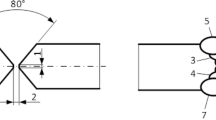Abstract
This paper is devoted to a finite element prediction of material damage distribution within the workpiece during wiping die bending processes. The damage mechanics approach has been used in this investigation in order to describe the progressive damage evolution within the sheet. A comparative study between the results obtained by the simulations using the Lemaitre and Gurson damage models is presented and discussed. The elastoplastic constitutive laws are integrated by means of an incremental formulation which has been implemented in the finite element code ABAQUS. The punch load, influenced by the friction coefficient, is investigated for different cases of die radius. The springback angle, which depends on the elastic properties of the material, is computed for all cases. Both models give similar results in the modelling of bending operations. The Gurson one is shown to have more flexibility for applications.










Similar content being viewed by others
References
Tang CY, Tai WH (2000) Material damage and forming limits of textured sheet metals. J Mater Process Technol 99:185–140
Tsukrov I, Kachanov M (2000) Effective moduli of an anisotropic material with elliptical holes of arbitrary orientational distribution. Int J Solids Struct 37:5919–5941
Gurson AL (1977) Continuum theory of ductile rupture by void nucleation and growth, part I, yield criteria and flow rules for porous ductile media. Trans ASME, J Eng Mater Technol 99:2–15
Sevostianov I, Kachanov M (2001) On the yield condition for anisotropic porous materials. Mater Sci Eng A313:1–15
Kalpakjian S (1991) Manufacturing process for engineering materials, 2nd edn, Addison-Wesley, USA
Krajcinovic D (1983) Constitutive equations for damaging materials. J Appl Mech 50:355–360
Wang TJ (1992) Unified CDM model and local criterion for ductile fracture-I, unified CDM model for ductile fracture. Eng Fract Mech 42:177–183
Wang TJ (1994) Further investigation of a new continuum damage mechanics criterion for ductile fracture: experimental verification and applications. Eng Fract Mech 48:217–230
Chandrakanth S, Pandey PC (1995) An isotropic damage model for ductile material. Eng Fract Mech 50:457–465
Bonora N (1997) A linear CDM model for ductile failure. Eng Fract Mech 58:11–28
Bonora N (1988) Low cycle fatigue life estimation for ductile metals using a nonlinear continuum damage mechanics model. Int J Struct 35:1881–1894
Bonora N, Salvini P, Lecoviello F (1996) Experimental identification of damage evolution law in Al-Li2091 alloy. XXV AIAS National meeting, Galipoli, pp 345–355
Lemaitre J, Chaboche JL (1988) Endommagement, mécanique des matériau solides. Dunod, Paris
Chaboche JL (1988) Continuum damage mechanics. Part I: general concepts. J Appl Mech 55:59–64
Chaboche JL (1988) Continuum damage mechanics. Part II: damage growth, crack initiation, and crack growth. J Appl Mech 55:65–72
Ye D, Wang Y (2001) An approach to investigate pre-nucleation fatigue damage of cyclically loaded metals using Vickers micro hardness tests. Int J Fatigue 23:85–91
Widmark M, Melander A, Meurling F (2000) Low cycle constant amplitude fully reversed strain controlled testing of low carbon and stainless sheet steels for simulation of straightening operations. Int J Fatigue 22:307–317
Simo JC, Taylor RL (1985) Consistent tangent operator for rate independent elastoplasticity. J Comput Meth Appl Mech Eng 48:101–118
Simo JC, Ju JW (1987) Strain and stress based continuum damage models I: formulation. Int J Solids Struct 7:821–840
Simo JC, Ju JW (1987) Strain and stress based continuum damage models II: computational aspects. Int J Solids Struct 23:841–869
Doghri I (1993) Fully implicit integration and consistent tangent modulus in elastoplasticity. Int J Numerical Methods Eng 36:3915–3932
Doghri I (1995) Numerical implementation and analysis of a class of metal plasticity models coupled with ductile damage. Int J Numerical Methods Eng 38:3403–3431
Murakami S (1998) Mechanical modelling of material damage. Trans ASME, J Appl Mech 55:280–286
Crisfield MA (1991) Basic plasticity, non-linear finite element analysis of solids and structures, Mc-Graw Hill, Great Britain, pp 152–199
Hibbit K, Sorensen Inc (1995) Mechanical constitutive theories. In: ABAQUS theory manual, version 5.5, pp 4.1.1.1–4.3.4.3
Kachanov LM (1986) Introduction to continuum damage mechanics, mechanics of elastic stability. Kluwer, USA
Hibbit K (2001) Porous metal plasticity. In: ABAQUS/Standard user’s manual, vol II, version 6.2, Sorensen Inc, pp 11.2.7–1–11.2.7–6
Tvergaart V (1991) Mechanical modelling of ductile fracture. Mech 26:11–16
Hambli R, Potiron A (2001) Damage and fracture prediction in bending process using 3D finite element model. In: Proceedings of the 9th international conference on sheet metal, Leuven, Belgium, pp 229–236
Hambli R, Potiron A (2001) Comparison between Lemaitre and Gurson damage models in crack growth simulation during blanking process. In: Proceedings of the 9th international conference on sheet metal, Leuven, Belgium, pp 555–562
Klingenberg W, Singh UP (2003) Finite element simulation of the punching/blanking process using in-process characterisation of mild steel. J Mater Process Technol 134(March):296–302
Magny C (2002) Lois de frottement évolutives destinées à la simulation numérique de l’emboutissage. La Revue de Métallurgie – CIT/Science et Génie des Matériaux, pp145–156
LP Lei, SM Hwang, BS Kang (2000) Finite element analysis and design in stainless steel sheet forming and its experimental comparison. J Mater Process Technol 110:70–77
Mkaddem A, Huneau B, Lebrun JL, Boude S (2003) Experimental quantification of damage in sheet metal bending process: comparison with numerical prediction. In: Proceedings of the 10th international conference on sheet metal, Belfast, North Ireland
Acknowledgments
The authors would like to thank Deville S.A Industry for its technical support.
Author information
Authors and Affiliations
Corresponding author
Rights and permissions
About this article
Cite this article
Mkaddem, A., Hambli, R. & Potiron, A. Comparison between Gurson and Lemaitre damage models in wiping die bending processes. Int J Adv Manuf Technol 23, 451–461 (2004). https://doi.org/10.1007/s00170-003-1701-3
Received:
Accepted:
Published:
Issue Date:
DOI: https://doi.org/10.1007/s00170-003-1701-3




